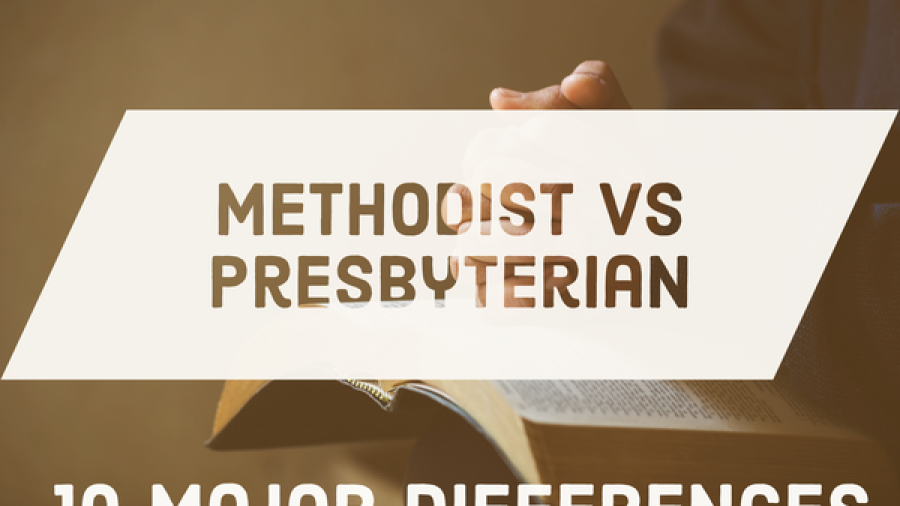What is the difference between the Methodist and Presbyterian church?
The Methodist and Presbyterian movements both got their beginnings in the Protestant movement before splitting into different denominations. They are also among the most well-liked among Christians in the US. However, in terms of their religious doctrine, rituals, and systems of government, both faiths have significant distinctions and overlaps. Learn the differences and similarities between two churches for a better understanding of faith and denominations.
What is a Methodist?
Methodists are a type of Protestant with roots in the writings of John and Charles Wesley, whose father was an Anglican priest. The branch of Christianity focuses on religion in the heart, not necessarily a strong outward display of faith. Additionally, they expect strict discipline in academic and spiritual concerns.
Methodist churches steer clear of confessions in favor of practical faith, keeping a strong distance from the Catholic faith. The Methodists placed a strong emphasis on the necessity for a personal experience of salvation and were concerned with personal holiness from the beginning. Overall, they adhere to general Wesleyan theology in terms of theory focusing on religious experience over formal dogma.
Methodists share the same convictions as most other protestant sects regarding the deity of Jesus Christ, the holiness of God, the wickedness of mankind, literal death, burial, and resurrection of Jesus for the salvation of mankind. Despite affirming the authority of the Bible, Methodists have a low level of belief in the inerrancy of Scripture (2 Timothy 3:16).
The teaching of the Methodists can sometimes be summed up in four distinct concepts known as the “four alls.” Original sin theory states that: everyone has to be saved; everyone can be saved; everyone can know they are saved, and everyone can be saved entirely.
What is a Presbyterian?
The Presbyterian faith is based on the Westminster Confession (1645–1647), the most well-known theological statement of English Calvinism. A broad range of churches that follow John Calvin and John Knox’s teachings to some extent and use a presbyterian style of church government run by representative elders or presbyters are collectively referred to as Presbyterian.
Presbyterians’ ultimate goals are to honor God through communion, divine worship, upholding the truth, reinforcing social justice, and displaying the Kingdom of Heaven to the entire world. Therefore, Presbyterians place strong significance on church elders, sometimes known as presbyters, which lead to the name. Additionally, Presbyterians place a strong emphasis on God’s omnipotence and justice along with the reality of the trinity, heaven, and hell. They also believe once a person is saved through faith, they can never be lost.
The depravity of man, God’s holiness, and redemption by faith are common themes among Presbyterian churches, although there is great variation in how those themes are defined and used. While some Presbyterian churches hold that the Bible is a human work prone to mistake, others hold that it is the verbally inspired, inerrant Word of God. In addition, Presbyterians differ in their acceptance of the virgin birth of Jesus as the divine Son of God.
Similarities between the Presbyterian and Methodist Church
Both Presbyterians and Methodists reject Catholic beliefs such as transubstantiation, which holds that the bread and cup at communion actually change into the flesh and blood of Christ. Additionally, they do not recognize the papacy’s supreme authority, praying to saints who have passed away, such as Mary, the mother of Jesus. Instead, both churches focus on the trinity and the kindness of God for salvation.
The main difference between the two churches focuses on salvation. While Methodists believe everyone who believes in God will gain salvation, Presbyterians believe God picks who is saved or not saved. Also, Methodists have a pastor as their lead with a council as a backup, while Presbyterians are elder-centric. Finally, Methodists believe saved men can be lost again, while Presbyterians believe once a person is saved, they are saved for always.
Methodists and Presbyterians view on baptism
Baptism is seen by Methodists as a symbol of a new life and regeneration and acts as a covenant between God and a person, either adult or infant. They also recognize the validity of all forms of baptism, including sprinkle, pour, immersion, etc. Methodists are willing to baptize both people who openly profess their faith and those whose sponsors or parents believe. Many Methodists view infant baptism as anticipatory, instilling a desire to seek God and repent of sin.
Presbyterians observe two sacraments, including baptism; the other is communion. The ritual of baptism serves as a new mandate to live as Christ’s disciples and spread the gospel to every nation on earth. In the act of baptism, God adopts us as loving children and constituents of the church, the body of Christ, cleansing us of sin as we reject the influence of evil and pursue His purpose and path. While open to baptism by water immersion, they prefer to sprinkle and pour water over the adult or infant being baptized.
Church government between Methodists and Presbyterians
While the two churches have similarities, one distinct difference centers on church governance. Although, both agree on the avoidance of Catholic dogma.
The Directory of Worship is a worship resource used by the Methodist Church. The “Book of Discipline,” on the other hand, serves as the Presbyterian Church’s worship manual. Moving forward, church pastor selection and accountability are handled differently in the two faiths. Pastors are “called” or hired by the Presbyterian faith to serve the local community. However, Methodists assign their current pastors, who are in charge of overseeing the distinct regions of the Methodist Churches, to various church locations.
Methodists tend toward a hierarchical system that hires and delegates church leadership at a local church conference. In contrast, Presbyterian churches have multiple levels of governance. Presbyteries are collections of local churches with a General Assembly compromising all the Synods. According to the church’s constitution, a group of elders (commonly referred to as governing elders) leads the church at the local level in accordance with the presbyteries, synods, and the General Assembly.
Comparing pastors of each denomination
Ordination governs the Methodist denomination, not by individual churches, as specified in the Book of Discipline. To choose and appoint new pastors, local church conferences consult with the district conference. Also, the church allows men and women to serve as pastors.
The presbytery traditionally ordains and selects pastors for Presbyterian churches, and appointments are typically made with the local church’s congregational approval of the presbytery’s decision along with direction from the Holy Spirit. After the process, the denomination can recognize someone as a Presbyterian pastor through ordination, which only takes place at the denominational level.
Sacraments
Methodists observe two sacraments, baptism and communion, both serving as symbols of God’s grace in Christ rather than as its actual components. However, baptism is more than just a profession; it is also a symbol of renewal. The Lord’s Supper is a symbol of a Christian’s atonement in a similar way. Some churches also support the Lord’s Supper as a sacrament but under the umbrella of communion.
Sacraments are rituals for the purpose of grace which the Presbyterians separate from Catholic rituals as they do not require strict adherence to doctrine. Instead, Presbyterians honor baptism and the Communion (or the Lord’s Supper), allowing God to work in a significant, spiritual, and unique way.
Famous pastors of each denomination
There are many famous pastors in both Methodist and Presbyterian churches. To start, the Methodists have a long list of famous Methodist pastors, including John and Charles Wesley, Thomas Coke, Richard Allen, and George Whitfield. During the current timeline, Adam Hamilton, Adam Weber, and Jeff Harper are well-known Methodist pastors. Presbyterian pastors from before including John Knox, Charles Finney, and Peter Marshall, with more recent famous additions of James Kennedy, R.C. Sproul, and Tim Keller.
Doctrinal Position of Methodists and Presbyterians
The Methodist denomination has always aligned itself with Arminian doctrinal principles. Predestination, perseverance of the saints, and other doctrines are rejected by the majority of Methodists in favor of prevenient (or anticipatory) grace.
Presbyterians stem from Reformed Protestantism focusing on the church elders. The branch also affirms that God has complete and total control over salvation, with men incapable of saving themselves. Furthermore, Presbyterians maintain that because of sin, man cannot move toward God and that, if left to their own devices, all men will reject God. Lastly, they focus on a confession of faith under the Westminster Confession as the standard.
Eternal Security
Methodists believe once a person is saved through faith, they are always saved, which means God will never turn away a person of faith, but the person can turn away from God and lose their salvation. However, some Methodist churches performance of works for righteousness. The Presbyterian Church, on the other hand, holds that one can only be justified by grace and are predestined to eternal salvation by God, not by faith.
Conclusion
Methodists and Presbyterians share several general characteristics but with significant variances. The two churches hold different views on predestination, with Methodists rejecting it and Presbyterians seeing it as true. Moreover, Presbyterians and Methodists also have distinctive elder-led leadership models, while the Methodist church is based on the historic bishop-led governmental structure. While different, both churches agree on faith in the trinity and follow the Bible with a few fundamental disagreements.

